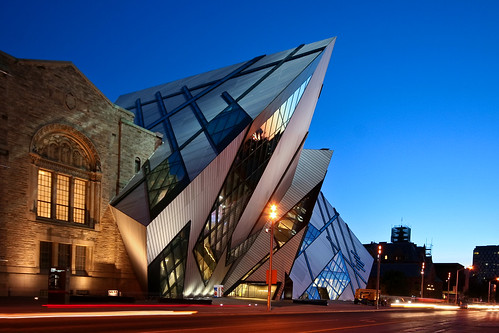
The Royal Ontario Museum (ROM) is a museum of world culture and natural history in Toronto, Ontario, Canada. With its main entrance facing Bloor Street in Downtown Toronto, the museum is situated north of Queen's Park and east of Philosopher's Walk in the University of Toronto. Founded in 1912, the museum has maintained close relations with the university throughout its history, often sharing expertise and resources.The museum remained under direct control and management of the University of Toronto until 1968, when it became an independent institution.
Containing more than six million items and forty galleries, the museum has notable collections of dinosaurs, Near Eastern and African art, East Asian art, European history, and Canadian history. It also houses the world's largest collection of fossils from the Burgess Shale with more than 150,000 specimens.
The ROM began in 1912 with the enactment of the Royal Ontario Museum Act by the provincial government. It was opened at 3 p.m. EST on March 14, 1914, by HRH The Duke of Connaught, Governor General of Canada. When the museum's site was first chosen, it was still at the edge of Toronto's built-up area and far from the city's central business district; the location was selected mainly for its proximity to the University of Toronto. The original building was constructed on the western edge of the property along the university's Philosopher's Walk, with its entrance opening on Bloor Street. It was the first phase of a two-part master plan which was to see the museum eventually expanded towards Queen's Park Crescent as an 'H' shaped building. Many of the artifacts were transferred from the museum's predecessor, the Museum of Natural History and Fine Arts at the Toronto Normal School.
The ROM's first expansion, opened on October 12, 1933, saw the construction of the wing fronting onto Queen's Park, and required the demolition of Argyle House, a Victorian mansion at 100 Queen's Park. To employ as many men as possible during the Great Depression, the excavation for the basements and foundations were undertaken by hand, with teams of workers working alternate weeks.
In 1964, the McLaughlin Planetarium was added to the south, and a multi-level atrium was added in 1975, doubling the floor space. By the 1980s, the planetarium's audiences were dwindling, and the planetarium was closed in 1995. It re-opened temporarily from 1998 to 2002, when the second floor space was rented to the Children's Own Museum. In 2009, the museum sold the building and property to the University of Toronto, which will redevelop the site for its purposes.
The second major addition to the museum was the Queen Elizabeth II Terrace Galleries on the north side of the building, and a curatorial centre built on the south, which were started in 1978, completed in 1984, The new construction meant that a former outdoor "Chinese Garden" to the north of the building facing Bloor, along with an adjoining indoor restaurant, had to be dismantled. Opened in 1984 by Queen Elizabeth II, a $55 million expansion took the form of layered volumes, each rising layer stepping back from Bloor Street, hence creating a layered terrace effect. The design of this expansion won a Governor General's Award in Architecture.
In 1989, activists complained about its Into the Heart of Africa exhibit; forcing the curator, Jeanne Cannizzo, to resign.
Beginning in 2002, the museum went through a major renovation and expansion project, dubbed Renaissance ROM. The centerpiece of the project is a major facility known as the Michael Lee-Chin Crystal, designed by architect Daniel Libeskind whose design was selected from among 50 entrants in an international competition. The design saw the Terrace Galleries torn down and replaced with a Deconstructivist crystalline-form structure, named after Michael Lee-Chin who donated $30 million towards its construction. Existing galleries and buildings were also upgraded, with installation of exhibits in the addition spanning a period of months. The final cost of the project was about $270 million CAD. The first phase of the Renaissance ROM project opened to the public 2005, while the Crystal was opened in 2007. Renovated galleries in the historic buildings reopened in stages, and all work was completed by 2010.















0 comments:
Post a Comment